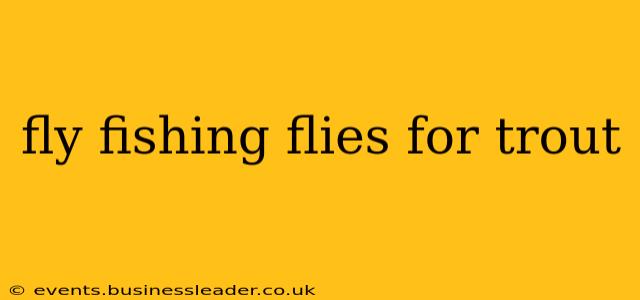Fly fishing for trout is a rewarding experience, but choosing the right fly can significantly impact your success. This guide dives deep into the world of trout flies, exploring various types, their effectiveness in different conditions, and how to select the perfect fly for your next fishing trip. Understanding the nuances of fly selection is crucial for any angler looking to improve their catch rate.
What are the best fly fishing flies for trout?
This is the million-dollar question, and unfortunately, there's no single answer. The "best" fly depends heavily on several factors: the time of year, the specific species of trout you're targeting, the water conditions (water clarity, flow, temperature), and the insects the trout are currently feeding on. However, certain fly patterns consistently prove effective across various situations.
What are some good beginner fly patterns for trout?
For beginners, focusing on a few versatile patterns is key. These flies are easy to tie, readily available in local fly shops, and effective across a range of conditions. Some excellent choices include:
- Adams: A classic dry fly, the Adams imitates a variety of mayflies and caddisflies. Its simple design makes it easy to cast and effective in many situations.
- Elk Hair Caddis: Another excellent dry fly, the Elk Hair Caddis mimics emerging caddisflies. Its buoyant elk hair body makes it highly visible on the water's surface.
- Prince Nymph: A versatile nymph pattern, the Prince Nymph imitates a variety of aquatic insects. Its attractive colors and weighted body make it effective in various depths.
- Wooly Bugger: A popular streamer fly, the Wooly Bugger imitates small baitfish and leeches. Its versatile design makes it effective in various water conditions.
What are the different types of trout flies?
Trout flies are categorized into several types, each designed to imitate specific insects or prey:
- Dry Flies: These flies float on the water's surface, imitating insects that are emerging or resting on the water.
- Nymphs: These flies imitate aquatic insects in their nymph stage, living underwater.
- Wet Flies: These flies sink below the surface, imitating insects or other aquatic organisms.
- Streamers: These larger flies imitate small fish, baitfish, or leeches.
How do I choose the right fly for different water conditions?
Water clarity significantly impacts fly selection. In clear water, subtle and realistic flies are crucial. In murky water, brighter and more visible flies are often more effective. Fast-flowing water necessitates weighted flies that can reach the trout's feeding zone. Slow-moving water allows for the use of lighter, more delicate flies.
What size flies should I use for trout?
Fly size is another critical factor. Smaller flies are generally more effective in clear water or when trout are feeding selectively. Larger flies are better suited for murky water or when trout are more aggressive. Experimentation is key to finding the right size for your specific conditions.
What colors of flies are best for trout?
Trout's vision is different than ours; they are more sensitive to certain wavelengths of light. However, general rules apply: Natural colors often work best in clear water, while brighter colors may be more effective in murky water. Matching the hatch (imitating the insects currently present) is paramount.
When is the best time of year to fly fish for trout?
Trout are active throughout the year, but the best time often depends on your location and the specific species. Spring and fall typically offer excellent fishing opportunities, as the water temperatures are often ideal, and insect activity is high. Summer can be challenging due to warmer water temperatures, while winter fishing requires specialized techniques and often relies on nymphs or streamers.
Conclusion
Selecting the right fly for trout is an art that develops with experience. Understanding the factors mentioned above – water conditions, time of year, insect life, and fly types – is crucial. Start with a few versatile patterns, experiment with different sizes and colors, and observe the trout's behavior to hone your skills. With practice and patience, you'll increase your chances of landing that trophy trout.
